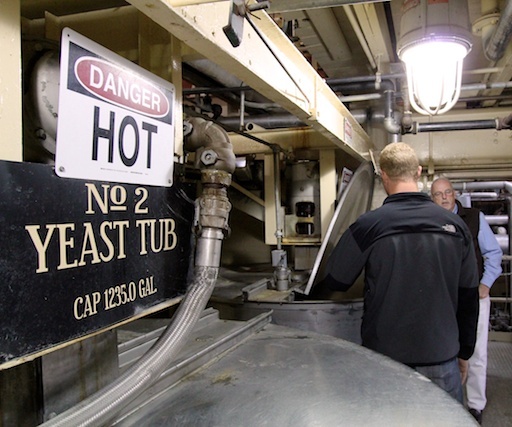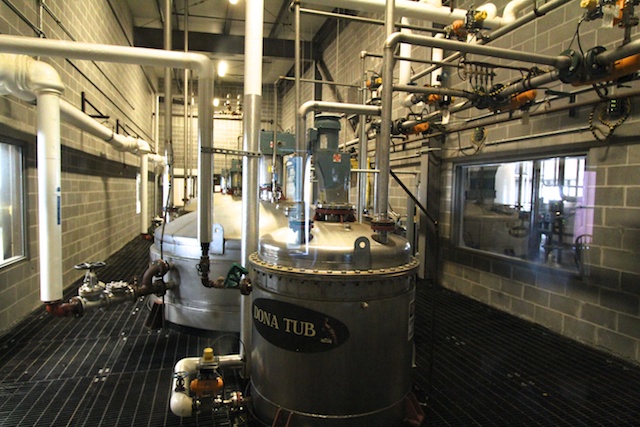Creating Different Bourbon Expressions #2
 Four Roses Yeast Tub #2Driscoll asked some really good questions last week about where the bourbon's flavor comes from. While the general consensus, at least for the marketing departments, is that you have a sour mash, you have a still, you have a barrel, you add some magic fairy dust and voila, delicious bourbon. The truth of the matter is much more complicated, but also I believe better studied than the marketers would have you believe. David noted that Buffalo Trace Distillery distinguishes between two similarly produced bourbons, Eagle Rare Single Barrel & Buffalo Trace, simply by their taste. They’re all very honest and open about how the barrels are selected, “these barrels right here, they taste like Eagle Rare.” While this seemingly simplistic answer is coming from the tour guide and not Harlan Wheatley it's certainly more detail than some distilleries divulge. If it was truly out of their control as to which barrels taste one way or another, one day the folks at Buffalo Trace might find that none of their bourbon tastes like Eagle Rare anymore. We cannot control the unknown afterall. I know from experience that drink companies do not take risks like this without some sort of contingency. We also know from various sources, as well as Mr. Jim Rutledge himself that the bourbon industry has spent years trying to understand exactly how the process works. Four Roses (and Seagram's before it) is basically a giant whiskey experiment that for many years has employed a number of scientists to help them understand how the flavor of whiskey develops. I'm certain that most, if not all, established Kentucky distilleries employ several sciency types to help them better understand whats going on. This quest stands in stark contrast to the motto embossed above the entrance of the Stitzel-Weller Ditsiller, “No Chemists Allowed.”
Four Roses Yeast Tub #2Driscoll asked some really good questions last week about where the bourbon's flavor comes from. While the general consensus, at least for the marketing departments, is that you have a sour mash, you have a still, you have a barrel, you add some magic fairy dust and voila, delicious bourbon. The truth of the matter is much more complicated, but also I believe better studied than the marketers would have you believe. David noted that Buffalo Trace Distillery distinguishes between two similarly produced bourbons, Eagle Rare Single Barrel & Buffalo Trace, simply by their taste. They’re all very honest and open about how the barrels are selected, “these barrels right here, they taste like Eagle Rare.” While this seemingly simplistic answer is coming from the tour guide and not Harlan Wheatley it's certainly more detail than some distilleries divulge. If it was truly out of their control as to which barrels taste one way or another, one day the folks at Buffalo Trace might find that none of their bourbon tastes like Eagle Rare anymore. We cannot control the unknown afterall. I know from experience that drink companies do not take risks like this without some sort of contingency. We also know from various sources, as well as Mr. Jim Rutledge himself that the bourbon industry has spent years trying to understand exactly how the process works. Four Roses (and Seagram's before it) is basically a giant whiskey experiment that for many years has employed a number of scientists to help them understand how the flavor of whiskey develops. I'm certain that most, if not all, established Kentucky distilleries employ several sciency types to help them better understand whats going on. This quest stands in stark contrast to the motto embossed above the entrance of the Stitzel-Weller Ditsiller, “No Chemists Allowed.”
 Buffalo Trace keeps boxes of packaged yeast on hand in the fermentation room (highlighted in the bottom circle)You don’t need to be a scientist to know exactly what factors go into the ultimate flavor of whisky. Simply examine the process from start to finish and all your inputs are there. We know that the mash bill, water source, grain quality, yeast strain, cook temperatures, distillation temperatures/proof, barrel entry proof, and warehousing decisions will ultimately affect the flavor. Certainly, as with Scotch, the time of year of distillations also affects the ultimate flavor as the grain profiles are seasonally variable and specifications of fermentations and distillation may change based on ambient temperature, humidity, and barometric pressure. The key to making great bourbon consistently is understanding how all those various factors intertwine to produce a certain flavor profile. Four Roses is really a perfect example of how important each factor is and how they can be controlled to interact with each other differently.
Buffalo Trace keeps boxes of packaged yeast on hand in the fermentation room (highlighted in the bottom circle)You don’t need to be a scientist to know exactly what factors go into the ultimate flavor of whisky. Simply examine the process from start to finish and all your inputs are there. We know that the mash bill, water source, grain quality, yeast strain, cook temperatures, distillation temperatures/proof, barrel entry proof, and warehousing decisions will ultimately affect the flavor. Certainly, as with Scotch, the time of year of distillations also affects the ultimate flavor as the grain profiles are seasonally variable and specifications of fermentations and distillation may change based on ambient temperature, humidity, and barometric pressure. The key to making great bourbon consistently is understanding how all those various factors intertwine to produce a certain flavor profile. Four Roses is really a perfect example of how important each factor is and how they can be controlled to interact with each other differently.
Each distillery has a proprietary process for fermentation. Clearly, the yeast is an incredibly important factor for creating a consistent product. Most distilleries cultivate yeast (either a single strain or multiple strains) using a souring process that’s completely separate from the fermentation of the bourbon. The yeast mash is first “soured” or inoculated with Lactobacillus in order to create a better environment for yeast to grow as well as prevent other negative bacteria to take over. These yeasts are usually re-cultivated on a weekly basis, meticulously tested, and evaluated to make sure that no mutations have occurred in the propagation process. Mutations are bad. This is then added to the mash during cooking to ensure that the proper yeast takes over during fermentation. The yeast will have a strong influence on flavor, but its ultimate importance is disputed. If you look at Four Roses, they’ve developed 5 yeast strains to offer different types of flavors.
 The Dona Tub at Wild TurkeyWhile, we assumed that these were developed out of simple experimentation or a search for a particular profile, Seagram’s had actually focused on yeast character in response to the closure of other plants and warehouse in various locations. When their Maryland plant closed they knew that they’d need to replace that flavor profile in the blends. Four Roses is the glorious result of esoteric decisions made by a company completely committed to blended whisky. Because Four Roses is so meticulous about its yeast cultivation, you don’t have many flavor outliers on either end of the spectrum. Jim even related a story about the one time in many decades they accidentally let the yeast cultivation go longer than usual, their mutant strain of yeast was one of the mot robust they’d ever had. This was nearly 20 years ago and Jim wondered aloud if it was that monstrously vigorous yeast that was used the week they distilled the legendary 18 year old bourbon that went into this year’s 125th Anniversary bottling. Needless to say, that special mutant strain was not cultivated further and the yeast was discarded despite possibly being responsible for one of the greatest bourbons ever produced there.
The Dona Tub at Wild TurkeyWhile, we assumed that these were developed out of simple experimentation or a search for a particular profile, Seagram’s had actually focused on yeast character in response to the closure of other plants and warehouse in various locations. When their Maryland plant closed they knew that they’d need to replace that flavor profile in the blends. Four Roses is the glorious result of esoteric decisions made by a company completely committed to blended whisky. Because Four Roses is so meticulous about its yeast cultivation, you don’t have many flavor outliers on either end of the spectrum. Jim even related a story about the one time in many decades they accidentally let the yeast cultivation go longer than usual, their mutant strain of yeast was one of the mot robust they’d ever had. This was nearly 20 years ago and Jim wondered aloud if it was that monstrously vigorous yeast that was used the week they distilled the legendary 18 year old bourbon that went into this year’s 125th Anniversary bottling. Needless to say, that special mutant strain was not cultivated further and the yeast was discarded despite possibly being responsible for one of the greatest bourbons ever produced there.
The reliance on yeast cultivation at Four Roses is a stark contrast to the way they do things at Buffalo Trace. No yeast cultivation occurs for regular distillation; instead they simply hold back a portion of the last batch and add a significant quantity of distillers yeast. So how can two wildly different approaches produce equally good bourbon on a consistent basis? What the hell, right?
more on that soon...
-David Othenin-Girard
